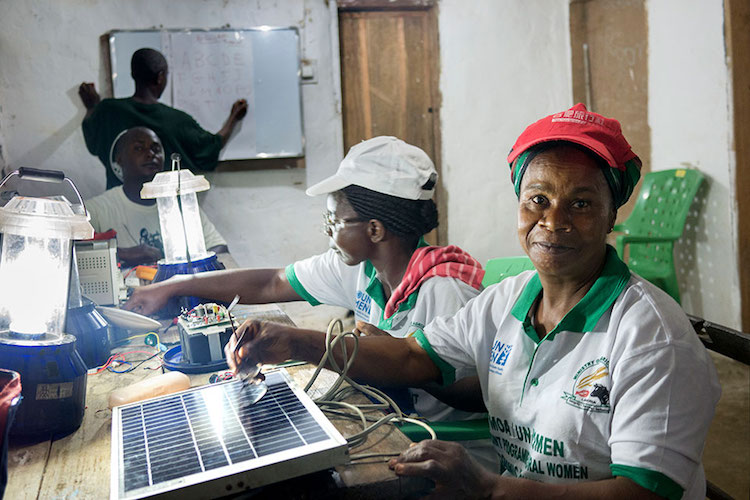By J Nastranis
NEW YORK (IDN) – Stories about women who have excelled in subjects like science, technology, engineering and mathematics (STEM) can help overcome bias against girls and create new role models, UN officials said on the occasion of the International Day of Women and Girls in Science on February 11.
A recent study, ‘Gender stereotypes about intellectual ability emerge early and influence children’s interests’, shows that by the age of 6, girls are already less likely than boys to describe their own gender as ‘brilliant’, and less likely to join an activity labelled for ‘very, very smart’ kids.
In fact research finds that girls and boys are strongly influenced in the development of their thinking and sense of themselves by narratives and stereotypes that start to be learnt at home and continue at school and through life, reinforced by the images and the roles they see in advertising, in films, books and news stories.
“So, how do we change this, and what should girls learn now that sets them up to thrive in a transformed labour market of the future?” asks Phumzile Mlambo-Ngcuka, Executive Director of UN Women.
“The answer,” she says in a recent OpEd, “is not simply more and better STEM subject teaching. They must also learn that girls have an equal place in that future. This isn’t a given. A major and underestimated obstacle for girls in STEM is the stereotype that has been created and perpetuated that boys are better at these subjects and careers.”
Therefore, not only is there a need to ensure that children enter and stay in education, but also to equally pay close attention to what they are learning. The changing future of jobs means that fields of study for children now in school should include equipping them for ‘new collar’ jobs in the Fourth Industrial Revolution.
Because jobs that do not exist today may be common within the next 20 years, in the green economy, or areas like robotics, artificial intelligence, biotechnology and genomics.
Mlambo-Ngcuka refers to Margot Lee Shetterly’s ‘Hidden Figures’, which tells the ‘untold story of the black women mathematicians who helped win the space race’. The book has now been released as a film and brings recognition to those who were doubly invisible at NASA – as women and as black women.
“Making accomplished women scientists visible is important for the accuracy of news and of history. It is also an essential part of building further scientific success,” declares Mlambo-Ngcuka.
Census data in the United States of America shows that women comprise 39 per cent of chemists and material scientists, and 28 per cent of environmental scientists and geoscientists.
“These are not the equal proportions that we ultimately want – but they are far higher levels of success in science than fiction tells us,” says Mlambo-Ngcuka. Alarmingly, best-selling movies have tended to significantly underrepresent the facts.
A 2015 global study supported by UN Women showed that, of the onscreen characters with an identifiable STEM job, only 12 per cent were women. “This tells us that women are still hidden figures in science – and it has a chilling effect on girls’ ambitions,” says the UN Women Executive Secretary.
UN Secretary-General António Guterres agreed in a messsge on the International Day of Women and Girls in Science on February 11: “For too long, discriminatory stereotypes have prevented women and girls from having equal access to education in science, technology, engineering and maths.”
He added: “As a trained engineer and former teacher, I know that these stereotypes are flat wrong. They deny women and girls the chance to realize their potential – and deprive the world of the ingenuity and innovation of half the population.”
On the International Day, he urged commitment to end bias, greater investments in science, technology, engineering and maths education for all women and girls, as well as opportunities for their careers and longer-term professional advancement, so that all can benefit from their ground-breaking future contributions.
According to a 2016 Girl-guiding survey, fewer than one in ten girls aged 7 to 10 in the UK said they would choose a career as an engineer or scientist. Un-learning this bias and changing the stereotypes is not a simple matter, says Mlambo-Ngcuka. Yet it’s essential, she adds, if we are to see boys and girls able to compete on a more equal footing for the jobs of the future. This goes hand in hand with the practical programmes that teach immediately relevant skills.
UN Women is working with partners around the world to close the gender digital gap. For example, in Moldova, GirlsGoIT teaches girls digital, IT and entrepreneurial skills and specifically promotes positive role models through video; similarly in Kenya and South Africa, 20 Mozilla Clubs for women and girls teach basic coding and digital literacy skills in safe spaces. [IDN-InDepthNews – 12 February 2017]
Photo: 26 women from 16 villages in Liberia, South Sudan, Tanzania, and Uganda were selected to participate in six months of training on building, installing and maintaining solar lamps and panels. Photo: Thomas Dworzak
IDN is flagship agency of the International Press Syndicate.

